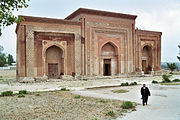
Islamic architecture
Islamic architecture comprises the architectural styles of buildings associated with Islam. It encompasses both secular and religious styles from the early history of Islam to the present day. The Islamic world encompasses a wide geographic area historically ranging from western Africa and Europe to eastern Asia. Certain commonalities are shared by Islamic architectural styles across all these regions, but over time different regions developed their own styles according to local materials and techniques, local dynasties and patrons, different regional centers of artistic production, and sometimes different religious affiliations.[1][2]
Early Islamic architecture was influenced by Roman, Byzantine, Iranian, and Mesopotamian architecture and all other lands which the early Muslim conquests conquered in the seventh and eighth centuries.[3][4][5][6][7] Further east, it was also influenced by Chinese and Indian architecture as Islam spread to South and Southeast Asia. Later it developed distinct characteristics in the form of buildings and in the decoration of surfaces with Islamic calligraphy, arabesques, and geometric motifs.[8] New architectural elements like minarets, muqarnas, and multifoil arches were invented. Common or important types of buildings in Islamic architecture include mosques, madrasas, tombs, palaces, hammams (public baths), Sufi hospices (e.g. khanqahs or zawiyas), fountains and sabils, commercial buildings (e.g. caravanserais and bazaars), and military fortifications.[2]




![The minaret of the Great Mosque of Aleppo (prior to its destruction in 2013), built circa 1090 during the Great Seljuk period[116]](http://upload.wikimedia.org/wikipedia/commons/thumb/8/8a/Aleppo_Great_Mosque_minaret_from_courtyard_8973.jpg/120px-Aleppo_Great_Mosque_minaret_from_courtyard_8973.jpg)





